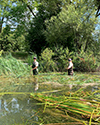Invasive Species Removal at Sandbanks
Phragmites australisTwenty years ago, the concern in Ontario wetlands was the proliferation of purple loosestrife, which has been eradicated naturally within the Park. Now we have a far more deadly threat. Originating in Europe and Asia, and first seen in Nova Scotia in 1910, the plant spread to Ontario by 1948. How it got to North America is unclear.
Once phragmites takes hold, it crowds out both native vegetation and small animals, creating a dead zone in the planted area. No mice, no snakes, no turtles, no birds and few insects. The plant out-competes native plants and can thrive in a wide variety of conditions. By growing in the muddy areas between land and water and along waterways, it usurps the habitat needed for migrating birds to find insects.
In some areas, such as Long Point, a three-stage process is used: application of a spray of Roundup and soybean oil followed by rolling the dead plants and then burning them. While the application of Roundup is controversial, (it seems counter-productive to add herbicides to the environment) most naturalists agree that this three-step program is the best way to combat this invasive plant when the plants are over land.
The program of phragmites removal at Sandbanks does not use any chemicals in the waterways, but elects to remove the plants manually by cutting the stems below the water level, a more labour-intensive process, albeit made much easier with the current high water conditions.
Click on any image to view/download a higher-resolution version.
For non-profit use only; please respect our image copyright.

|

|

|

|

|

|

|

|

|

|

|

|
In 2019, removal focussed on the Outlet River, betweeen the mouth at Lake Ontario and the first bridge to the east (shown below on the map).
The top images show an area opposite the hydro substation near the junction of Ridge Road and County Road 12, and show a now rare clump of purple loosestrife along with the phragmites. <
The middle right image above shows the growth of a stolon, which helps propagate the plant above ground. In the fall, tens of thousands of small windborne seeds allow the plant to be further dispersed.
Invasive Phragmites:
- Grows in stands that can be extremely dense with as many as 200 stems per square metre
- Can grow so densely that it crowds out other species
- Can reach heights of up to 5 metres (15 feet)
- Has stems that are tan or beige in colour with blue-green leaves and large, dense seedhead with up to 2000 seeds each
